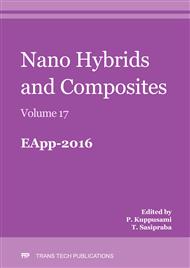[1]
D. Larcher and J.M. Towards greener and more sustainable batteries for electrical energy storage, Tarascon Nature Chemistry, 7 (2015) 19–29.
DOI: 10.1038/nchem.2085
Google Scholar
[2]
J.M. Tarascon and M. Armand, review article Issues and challenges facing rechargeable lithium batteries, Nature, 414 (2001) 359-367.
DOI: 10.1038/35104644
Google Scholar
[3]
John B. Goodenough and Kyu-Sung Park, The Li-Ion Rechargeable Battery: A Perspective, J. Am. Chem. Soc, 135 (2013) 1167–1176.
DOI: 10.1021/ja3091438
Google Scholar
[4]
Rotem Marom, S. Francis Amalraj, Nicole Leifer, David Jacob and Doron Aurbach, A review of advanced and practical lithium battery materials, J. Mater. Chem., 21 (2011) 9938-9954.
DOI: 10.1039/c0jm04225k
Google Scholar
[5]
Naoki Nitta Feixiang, Wu Jung Tae Lee and Gleb Yushin, Li-ion Battery Materials: Present and Future, Materials Today, 18 (2015) 252-264.
DOI: 10.1016/j.mattod.2014.10.040
Google Scholar
[6]
Chaofeng Liu, Zachary G. Neale and Guozhong Cao, Understanding electrochemical potentials of cathode materials in rechargeable batteries, Materials Today Volume 19, Materials Today, 19, (2016) 109.
DOI: 10.1016/j.mattod.2015.10.009
Google Scholar
[7]
Zhengliang Gong and Yong Yang, Recent advances in the research of polyanion-type cathode materials for Li-ion batteries, Energy Environ. Sci., 4 (2011) 3223.
DOI: 10.1039/c0ee00713g
Google Scholar
[8]
Christian M. Julien, Alain Mauger, Karim Zaghib and Henri Groult, Comparative Issues of Cathode Materials for Li-Ion Batteries, Inorganics 2, (2014) 132.
DOI: 10.3390/inorganics2010132
Google Scholar
[9]
V. Aravindan, K. Karthikeyan, S. Ameresh and Y. S Lee, LiMnBO3/C: A Potential Cathode Material for Lithium Batteries, Bull. Korean chem. Soc 31 (2010) 1506.
Google Scholar
[10]
Li S, Xu L, Li G, Wang M and Zhai Y, Performance degradation of a direct borohydride fuel cell, J Power Sources 236 (2013) 54.
Google Scholar
[11]
Barpanda P, Dwibedi D, Ghosh S, Kee Y and Okada, Lithium metal borate (LiMBO3) family of insertion materials for Li-ion batteries: a sneak peak, S Ionics 21 (2015) 1801.
DOI: 10.1007/s11581-015-1463-6
Google Scholar
[12]
Kim JC, Seo DH, Chen H and Ceder G, The Effect of Antisite Disorder and Particle Size on Li Intercalation Kinetics in Monoclinic LiMnBO3, Adv Energy Mater 5, (2015), 1401916.
DOI: 10.1002/aenm.201401916
Google Scholar
[13]
V. Legagneur, Y. An, A. Mosbah, R. Portal, A. Le Gal La Salle, A. Verbaere, D. Guyomard and Y. Piffard, LiMBO3 (M=Mn, Fe, Co): synthesis, crystal structure and lithium deinsertion/insertion properties, Solid State Ionics 139 (2001) 37.
DOI: 10.1016/s0167-2738(00)00813-4
Google Scholar
[14]
Ling Chen, Yanming Zhao, Xiaoning An, Jianmin Liu, Youzhong Dong, Yinghua Chen, Quan Kuang Ling Chen and Yanming Zhao, J. Alloy. Compd, 494 (2010) 415-419.
Google Scholar
[15]
Shouli Li, Liqiang Xu, Guangda Li, Meng Wang, Yanjun Zhai, Performance degradation of a direct borohydride fuel cell, J. Power Sources 236 (2013) 54-60.
Google Scholar
[16]
P. Barpanda Y. Yamashita S.C. Chung, Y. Yamada S. Nishimura and A. Yamada Sodium iron pyrophosphate: A novel 3. 0 V iron-based cathode for sodium-ion batteries, ECS Trans, 24 (2013) 116-119.
DOI: 10.1016/j.elecom.2012.08.028
Google Scholar
[17]
Dong-Hwa Seo, Young-Uk Park, Sung-Wook Kim, Inchul Park, R. A. Shakoor and Kisuk Kang, First-principles study on lithium metal borate cathodes for lithium rechargeable batteries, Phys. Rev B, 83 (2011) 205127.
DOI: 10.1103/physrevb.83.205127
Google Scholar
[18]
Semih Afyon, Christian Mensing, Frank Krumeich, Reinhard Nesper, The electrochemical activity for nano-LiCoBO3 as a cathode material for Li-ion batteries, Solid State Ionics, 256 (2014) 103-108.
DOI: 10.1016/j.ssi.2014.01.010
Google Scholar
[19]
Yong-Suk Lee and Hyukjae Lee, Structure and electrochemical behavior of LiMnBO3 synthesized at various temperatures, Electron Mater Lett, (2014) 253- 258.
DOI: 10.1007/s13391-013-3170-7
Google Scholar
[20]
Y. -S. Lee and H. Lee, Structure and electrochemical behavior of LiMnBO3 synthesized at various temperatures, J Ceram Process Res, 13, (2012) 253-258.
Google Scholar
[21]
Rui Ma Lianyi Shao Kaiqiang Wu Mengmeng Lao Miao Shui Cheng Chen Dongjie Wang Nengbing Long Yuanlong Ren Jie Shu, A New Look at Lithium Cobalt Oxide in a Broad Voltage Range for Lithium-Ion Batteries, Ceram. Int 39 (2013) 3323-3328.
DOI: 10.1021/jp911994b
Google Scholar
[22]
Kun-Jae Lee, Lee-Seung Kang, Sunghyun Uhm, Jae Sik Yoon, Dong-Wan Kim and Hyun Seon Hong, Synthesis and characterization of LiMnBO3 cathode material for lithium ion batteries, Curr. Appl. Phy, 13 (2013) 1440.
DOI: 10.1016/j.cap.2013.04.027
Google Scholar
[23]
Kaliyappan Karthikeyan and Yun Sung Lee, Microwave synthesis of high rate nanostructured LiMnBO3 with excellent cyclic behavior for lithium ion batteries, RSC Adv., 4 (2014) 31851.
DOI: 10.1039/c4ra04400b
Google Scholar
[24]
Ting Ma, Arzugul Muslim and Zhi Su, Microwave synthesis and electrochemical properties of lithium manganese borate as cathode for lithium ion batteries J. Power Sources, 282 (2015) 95.
DOI: 10.1016/j.jpowsour.2015.02.013
Google Scholar
[25]
Anping Tang, Donghua He, Zeqiang He, Guorong Xu, Haishen Song and Ronghua Peng, Electrochemical performance of LiMnBO3/C composite synthesized by a combination of impregnation and precipitation followed by annealing, J. Power Sources 275 (2015).
DOI: 10.1016/j.jpowsour.2014.11.087
Google Scholar
[26]
Semih Afyon, Dipan Kundu, Frank Krumeich and Reinhard Nesper, A low dimensional composite of hexagonal lithium manganese borate (LiMnBO3), a cathode material for Li-ion batteries, J. Power Sources, 224 (2013) 145.
DOI: 10.1016/j.jpowsour.2012.09.099
Google Scholar
[27]
Anping Tang, Donghua He, Jie Shen, Guorong Xiu and Ronghua Peng, Improved Synthesis of Graphene Oxide 59, 63 ECS Trans, (2014).
Google Scholar


